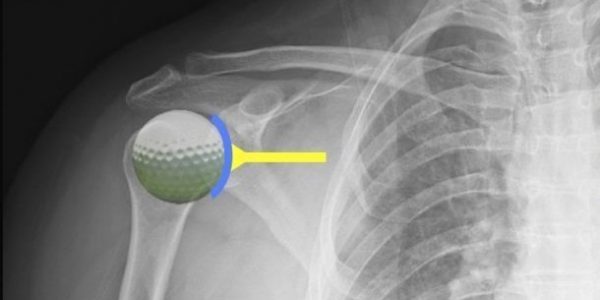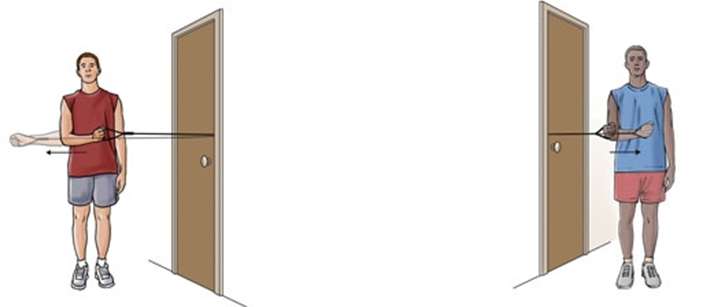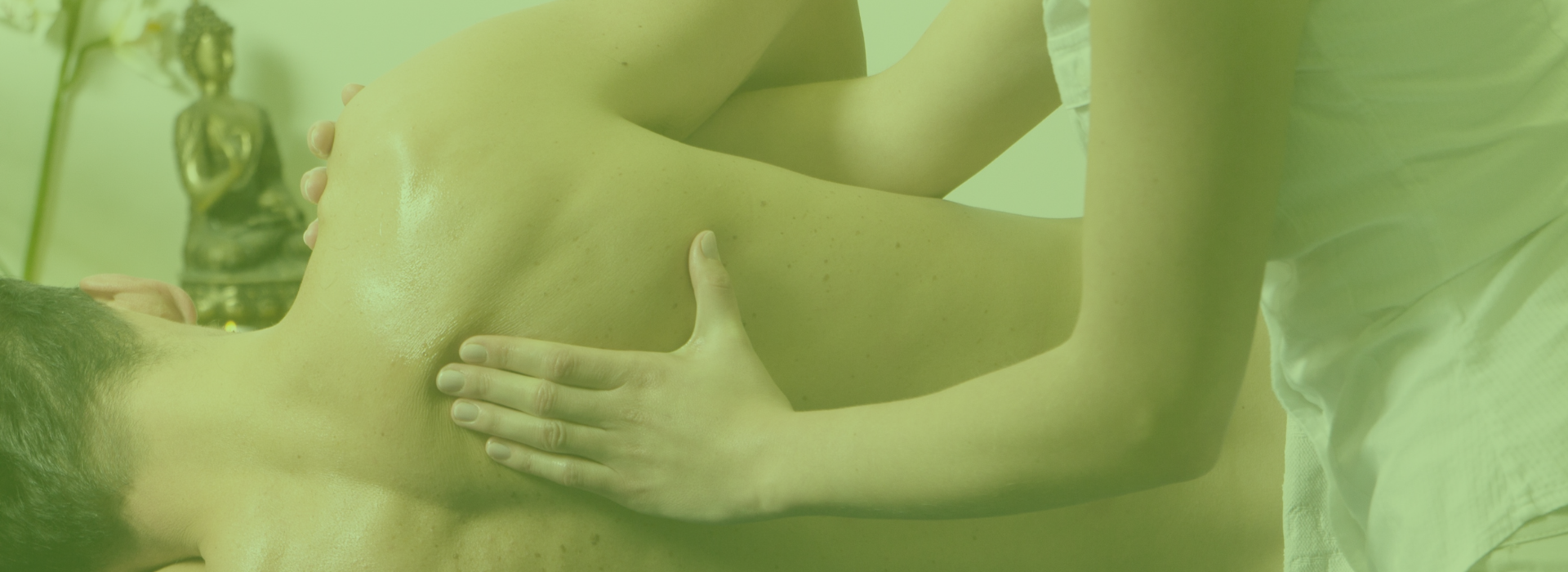Shoulder dislocation Treatment is common due to the frequency of this type of injury.
But why is dislocation of the shoulder statistically common?
Physio for shoulder dislocation is prescribed frequently due to the shoulder having the largest amount of motion of any joint in the body. This also means it can be unstable. Like all other joints, the shoulder has ligaments for support. However, muscles surrounding the shoulder need to play a key role in controlling the shoulder, particularly the rotator cuff.
A dislocated shoulder is when the ball of your upper arm bone is forced fully out of the shoulder socket.
WHY DOES THE SHOULDER BECOME UNSTABLE?
Think of the shoulder joint like a golf ball sitting on a tee. The golf ball is much larger than the tee. To help with the stability of the joint there is the labrum (blue). It makes the surface of the tee a little larger.
The main stability though, comes from the muscles. They act like ropes to hold the ball on the tee as the ball rolls around. The rotator cuff muscles blend together almost forming a blanket which covers the entire ball of joint.

HOW DOES A SHOULDER DISLOCATION HAPPEN?
In 98% of cases, the shoulder displaces forwards, and in the other 2% of cases it displaces backwards. A forward dislocation happens when the arm is forced into abduction, hyperextension, and external rotation.
Think about if you were to throw a tennis ball. If your shoulder was forced into that position, that is when you’re are at greatest risk of dislocating your shoulder.
Sometimes people can dislocate their shoulder just by falling onto an outstretched arm. 95% of first-time shoulder dislocations result from trauma with the other 5% of dislocations of atraumatic origin (eg. during sleep).
Some people are at increased risk of shoulder dislocations. This may be due to individual differences in the bony structures of the shoulder joint. An example is if you have a shallow gelnoid fossa (the tee part of the joint), this means the head of the humerus (the ball part of the joint) has a smaller groove to balance on.
Ligament laxity can also increase your risk of suffering a shoulder dislocation. This may be due to previous dislocation(s) or repetitive stretching of the ligaments with throwing and/or other overhead activities.
Repetitive throwing puts the shoulder in a vulnerable position, stretching the ligaments which normally provide the restraint to excessive movement.
Now that we have helped explain how the injuries can occur, what options are available, such as shoulder dislocation physiotherapy, to aid the healing process?
I HAVE DISLOCATED SHOULDER. WHAT NOW?
A dislocated shoulder will be accompanied by severe pain and muscle spasms. Sometimes following a shoulder dislocation, it may spontaneously reduce, meaning return to its normal position or ‘pop back in’. This will often be accompanied by immediate resolution of pain.
If your shoulder does not relocate by itself, you need to go to the emergency department of the hospital where a doctor can reduce it for you. They often use pain relief and muscle relaxations to make it a less painful process.
It is important you get a health professional and not your friend to put your shoulder back into position as it is possible to cause nerve damage when relocating a shoulder, if done incorrectly.

DO I NEED SURGERY FOR MY SHOULDER DISLOCATION?
Not necessarily.
The indication for shoulder stabilisation surgery is a history of recurrent dislocations. Recurrent dislocations are not uncommon following a first-time dislocation. They are especially common in younger adolescent patients and become less common with increasing age.
The biggest risk factor for ongoing instability is age < 25 years. Other risk factors are participation in a contact/collision sports and patients repetitively in an overhead position due to their occupation. Some studies have found that initially unstable shoulders can stabilise over time.
The conservative option for treatment often involves immobilisation of the injured shoulder in a sling for a period of 4-6 weeks based on the recommendation of your physiotherapist. This is followed by a program of range of motion then strengthening exercises.
Ultimately the best course of rehabilitation following a shoulder dislocation should be made in agreement with your physiotherapist.
Our physio Brisbane team are experts at assessing and treating shoulder injuries including dislocations.
WHAT DOES PHYSIO FOR SHOULDER DISLOCATION INVOLVE?
Regardless of whether the surgical or conservative road is chosen, shoulder dislocation treatment following the immobilisation period is very much the same. It is important to work closely with a physiotherapist, like one of our own here at Pivotal Motion Physiotherapy They will guide you through each stage of your rehab.
Following immobilisation the number one goal is to restore full range of motion. If range of motion isn’t restored initially it becomes even harder to get back. Range of motion is restored through repetitive stretches and/or movements often using a broomstick or pulley to help get that little bit of extra movement.


The secondary goal is to restore muscle strength. Most importantly the strength of the rotator cuff muscles. Restoring the rotator cuff muscle strength is especially important as they control movement at the shoulder. Weakness of these muscles can contribute to future shoulder issues.
Strengthening muscles which surround and control the shoulder blade are also an important component of any shoulder dislocation physiotherapy program. The scapular/shoulder blade contributes to range of motion at the shoulder and also provides a stable base for the arm. Without a stable base we cannot lift or resist heavy loads.
These muscles to coordinate which each other to control overhead movement. The combination of timing and activation exercises helps restore full function of these muscles.

WILL I HAVE TO TAPE MY SHOULDER?
In this video, we demonstrate how to tape a shoulder for anterior dislocation. This prevents the shoulder from going into an extreme range of external rotation and abduction. This reduces the likelihood of a future dislocation and may help with your confidence in returning to sport. The taping helps supplement shoulder dislocation treatment but is not a replacement for a graduated strengthening program.
Our physio Brisbane team are leaders in exercise and sports physiotherapy. For more information on shoulder injury physio options, talk to a Brisbane exercise physiologist from our clinic today! If you are after more information regarding a shoulder injury book a consultation online or call us today on 07 3352 5116.

